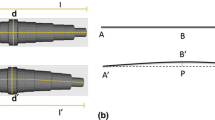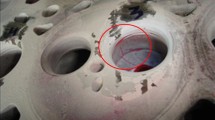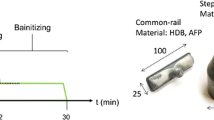Abstract
Computer simulation is used to predict the residual stresses and distortion of a full-float truck axle shaft that has been induction scan hardened. Flux2D® is used to model the electromagnetic behavior and the power distributions inside the axle shaft in terms of time. The power distributions are imported and mapped into DANTE® model for thermal, phase transformation, and stress analysis. The truck axle shaft has three main geometrical regions: the flange/filet, the shaft, and the spline. Both induction heating and spray quenching processes have significant effect on the quenching results: distortion and residual stress distributions. In this study, the effects of spray quenching severity on residual stresses and distortion are investigated using modeling. The spray quenching rate can be adjusted by spray nozzle design, ratio of polymer solution, and quenchant flow rate. Different quenching rates are modeled by assigning different heat transfer coefficients as thermal boundary conditions during spray quenching. In this paper, three heat transfer coefficients, 5, 12, and 25 kW/(m2 °C), are applied while keeping all other conditions constant. With the understanding of effects of heating and quenching on residual stresses and distortion of induction hardened parts, the induction hardening process can be optimized for improved part performance.














Similar content being viewed by others
References
G. Goldstein, V. Nemkov, and J. Jackowski, Virtual Prototyping of Induction Heat Treating, 25th ASM Heat Treating Society Conference, 2009
B. Ferguson and W. Dowling, Predictive Model and Methodology for Heat Treatment Distortion, NCMS Report #0383RE97, 1997
V. Warke, R. Sisson, and M. Makhlouf, FEA Model for Predicting the Response of Powder Metallurgy Steel Components to Heat Treatment, Mater. Sci. Eng. A, 2009, 518(1-2), p 7–15
D. Bammann et al., Development of a Carburizing and Quenching Simulation Tool: A Material Model for Carburizing Steels Undergoing Phase Transformations, Proceedings of the 2nd International Conference on Quenching and the Control of Distortion, November 1996, p 367–375
B.L. Ferguson, A.M. Freborg, and Z. Li, Probe Design to Charactrize Heat Transfer during Quenching Process, Proceedings of 6th International Quenching and Control of Distortion Conference, Chicago, IL, September 9-13, 2012, p 792–801
V. Nemkov, G. Goldstein, and J. Jackowski, Stress and Distortion Evolution During Induction Case Hardening of Tube, 26th ASM Heat Treating Society Conference, 2011.
R. Goldstein, V. Nemkov, and R. Madeira, Optimizing Axle-Scan Hardening Inductors. Industrial Heating, December 2007
Z. Li, B. Ferguson, and A. Freborg, Data Needs for Modeling Heat Treatment of Steel Parts, Proceedings of Materials Science & Technology Conference, 2004, p 219–226
Author information
Authors and Affiliations
Corresponding author
Rights and permissions
About this article
Cite this article
Li, Z., Ferguson, B.L., Nemkov, V. et al. Effect of Quenching Rate on Distortion and Residual Stresses During Induction Hardening of a Full-Float Truck Axle Shaft. J. of Materi Eng and Perform 23, 4170–4180 (2014). https://doi.org/10.1007/s11665-014-1196-0
Received:
Revised:
Published:
Issue Date:
DOI: https://doi.org/10.1007/s11665-014-1196-0




